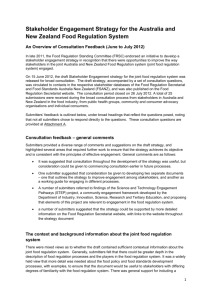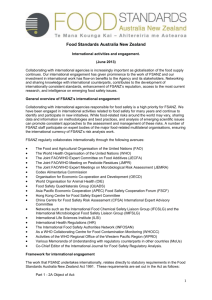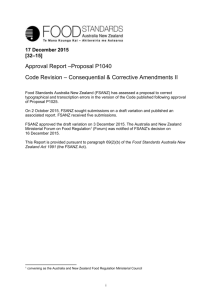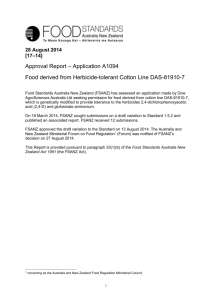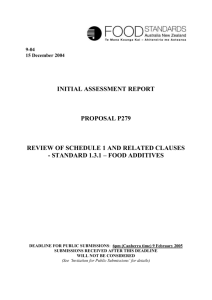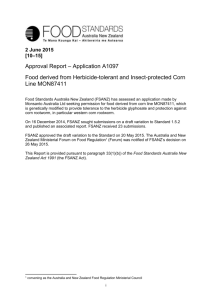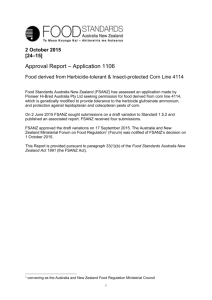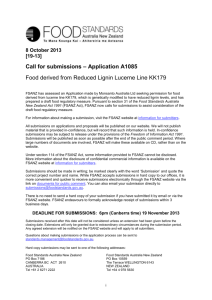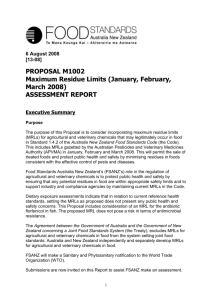Submission 1 - Food Standards Australia New Zealand
advertisement
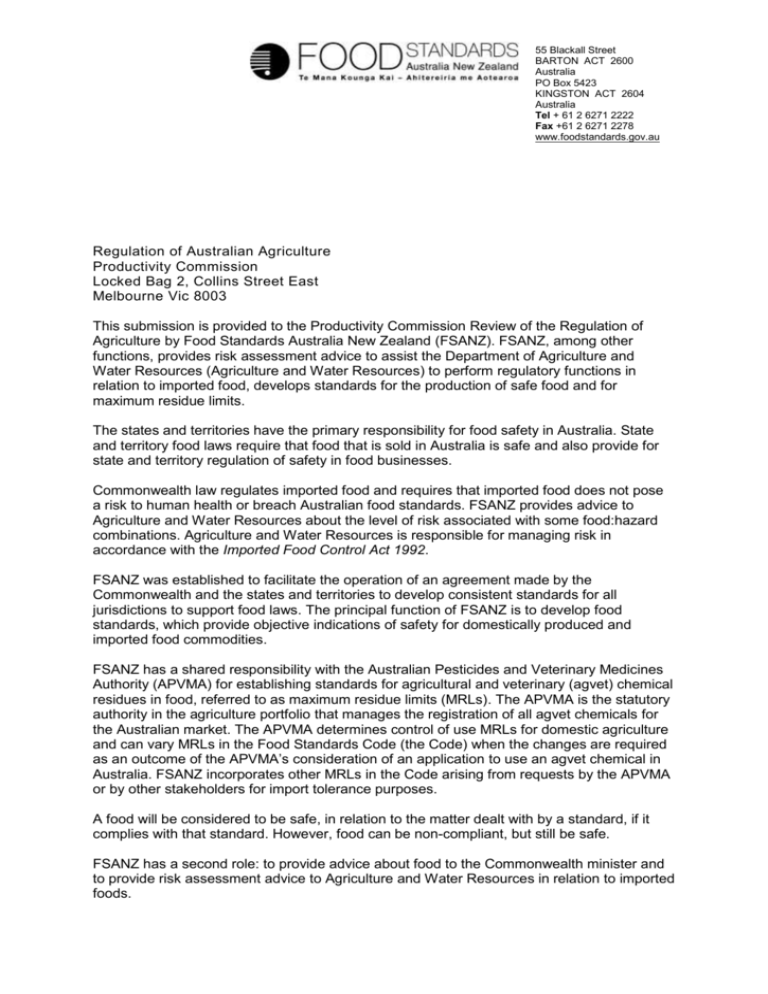
55 Blackall Street BARTON ACT 2600 Australia PO Box 5423 KINGSTON ACT 2604 Australia Tel + 61 2 6271 2222 Fax +61 2 6271 2278 www.foodstandards.gov.au Regulation of Australian Agriculture Productivity Commission Locked Bag 2, Collins Street East Melbourne Vic 8003 This submission is provided to the Productivity Commission Review of the Regulation of Agriculture by Food Standards Australia New Zealand (FSANZ). FSANZ, among other functions, provides risk assessment advice to assist the Department of Agriculture and Water Resources (Agriculture and Water Resources) to perform regulatory functions in relation to imported food, develops standards for the production of safe food and for maximum residue limits. The states and territories have the primary responsibility for food safety in Australia. State and territory food laws require that food that is sold in Australia is safe and also provide for state and territory regulation of safety in food businesses. Commonwealth law regulates imported food and requires that imported food does not pose a risk to human health or breach Australian food standards. FSANZ provides advice to Agriculture and Water Resources about the level of risk associated with some food:hazard combinations. Agriculture and Water Resources is responsible for managing risk in accordance with the Imported Food Control Act 1992. FSANZ was established to facilitate the operation of an agreement made by the Commonwealth and the states and territories to develop consistent standards for all jurisdictions to support food laws. The principal function of FSANZ is to develop food standards, which provide objective indications of safety for domestically produced and imported food commodities. FSANZ has a shared responsibility with the Australian Pesticides and Veterinary Medicines Authority (APVMA) for establishing standards for agricultural and veterinary (agvet) chemical residues in food, referred to as maximum residue limits (MRLs). The APVMA is the statutory authority in the agriculture portfolio that manages the registration of all agvet chemicals for the Australian market. The APVMA determines control of use MRLs for domestic agriculture and can vary MRLs in the Food Standards Code (the Code) when the changes are required as an outcome of the APVMA’s consideration of an application to use an agvet chemical in Australia. FSANZ incorporates other MRLs in the Code arising from requests by the APVMA or by other stakeholders for import tolerance purposes. A food will be considered to be safe, in relation to the matter dealt with by a standard, if it complies with that standard. However, food can be non-compliant, but still be safe. FSANZ has a second role: to provide advice about food to the Commonwealth minister and to provide risk assessment advice to Agriculture and Water Resources in relation to imported foods. Finally, FSANZ has a third role: to work with the states and territories to coordinate their responses to recalls and food safety incidents. This role is exercised through the implementation of a recall protocol that has been agreed with all jurisdictions. FSANZ coordinates recalls, which are initiated by one of the states or territories. It is important to note that FSANZ is not empowered to take enforcement action or otherwise regulate the production or sale of food. Moreover, FSANZ has no power to direct the responses of other agencies. Food safety policy is developed cooperatively by the ministers who are members of the Australia and New Zealand Ministerial Forum on Food Regulation. They are supported by a committee of senior officials from each jurisdiction who are responsible for advising the ministers on food regulation policy. FSANZ is not a member of that committee, but attends meetings as an adviser. The advisory role of FSANZ in relation to imported food is described in the Food Standards Australia New Zealand Act as “to develop assessment policies in relation to food imported into Australia”. This role is performed by identifying hazards of concern in food and providing risk assessment advice to Agriculture and Water Resources about the level of risk. Advice might be provided following a request from Agriculture and Water Resources or on our own initiative. The Imported Food Control Act provides that Agriculture and Water Resources is responsible for managing the risks associated with imported food. If food has been identified by FSANZ as a risk greater than medium, some risk management measures, such as a higher rate of inspection, are set out in the Imported Food Control Act. Some of the regulatory powers of Agriculture and Water Resources can be exercised only after assessment advice has been sought from FSANZ. It is important to note that while FSANZ has a clear responsibility to provide risk assessment advice, any decision about the use of advice in managing a risk is entirely a decision of Agriculture and Water Resources. FSANZ is an adviser, not a decision maker. A Memorandum of Understanding between FSANZ and Agriculture and Water Resources sets out the roles of the two agencies in order to avoid uncertainty or duplication. Primary Production and Processing Standards In 2002, the ministers responsible for food regulation asked FSANZ to extend its evidencebased standard-setting process to the primary production sector and provided FSANZ with a Policy Guideline on Primary Production and Processing Standards (PPP standards). This guideline specifies the objectives that FSANZ must have regard to when considering whether or not to develop standards. These are providing controls to protect public health and safety; reducing the regulatory burden on the food sector, governments and consumers and recognising the responsibility for food safety involves all levels of government and a variety of agencies within the governments. Development and application of primary production and processing standards to industry sectors is dependent on an analysis of the public health and safety risks, economic and social factors and current regulatory and industry practices. FSANZ has completed this work. PPP standards (which only apply in Australia) aim to strengthen food safety and traceability throughout the food supply chain from paddock to plate. Standards developed by FSANZ, with the assistance of other Australian government agencies, industry stakeholders and consumer groups include: Seafood (Standard 4.2.1) Poultry Meat (Standard 4.2.2) Meat and meat products (Standard 4.2.3) Dairy (Standard 4.2.4) - including amendments made for raw milk cheeses Eggs and Egg Products (Standard 4.2.5) Seed sprouts (Standard 4.2.6) State and territory regulatory agencies and the Department of Agriculture and Water Resources are responsible for implementing the standards. Maximum residue limits MRLs can be established or changed in the Code through several routes. The APVMA can amend the Code to include agvet chemicals for domestic use. The FSANZ MRL proposal process considers requests from domestic or international stakeholders, for harmonisation of MRLs to facilitate importation of food commodities, annually. FSANZ also has an MRL application route through which an application may be made to amend Standard 1.4.2 of the Code. Low level chemical residues in food Currently there must be no detectable residue of an agvet chemical in a food commodity if the chemical has no MRL in the Code. This requirement, referred to as a ‘zero tolerance’ approach, may be inappropriate to address low levels of inadvertent contamination of food with agvet chemicals already listed in the Code, but have no established MRLs for the specific chemical and food commodity combination. The unintended presence of low levels of agvet chemicals can occur through spray drift, crop rotation practices or contamination through the use of packaging equipment. The residue level from inadvertent exposure is generally low and presents no public health and safety concerns. However, this creates a predicament for enforcement agencies because such food is in breach of the Code and may not be sold even though it might be safe to eat. Through Proposal P1027 - Managing Low-level Agricultural & Veterinary Chemicals without Maximum Residue Limits, FSANZ has developed an approach to manage the inadvertent presence in food commodities of low-level agvet chemicals without MRLs in the Code. The approach will establish all other foods MRLs for specific chemicals already listed in the Code to account for the inadvertent presence of low level residues in some food commodities. The approach requires no substantial change to the Code; is currently used by the APVMA for a limited number of chemicals; is consistent with the APVMA’s risk assessment framework for approving and registering agvet chemical products and is consistent with the risk assessment approach for setting MRLs. The approach gives chemical users, importers and food regulators a clear and transparent target for monitoring. Furthermore, it allows the MRLs to be reviewed as required based on new information made available through state/territory and border regulatory activities. Peter May General Manager Food Safety and Regulatory Affairs 15 December 2015
